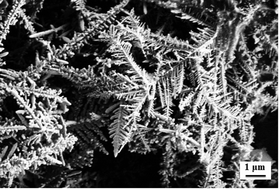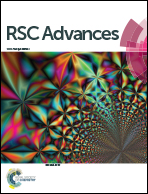Carbon nanotube and graphene oxide directed electrochemical synthesis of silver dendrites†
Abstract
We report a simple one-step electro-deposition method for the synthesis of silver dendritic structures with the aid of graphene oxide (GO) modified multi-walled carbon nanotubes (MWCNTs) which are dispersed in an AgNO3 solution. Scanning electron microscopy indicated that the formed silver material had a well-defined dendritic structure and XRD confirmed that the silver was in a cubic phase. UV-vis spectroscopy indicated the presence of GO in the silver dendrites which was electrochemically reduced during the silver electro-deposition process. It was found that the presence of MWCNT is crucial for the formation of the dendrite structure of the deposited Ag. The concentration of AgNO3 and the electrochemical deposition cycles also had significant effects on the shape of the formed nanostructures. A possible growth mechanism for the Ag dendrites was proposed based on the experimental results. In addition, the electro-catalytic properties of the as-prepared silver dendrites towards the reduction of hydrogen peroxide were investigated by cyclic voltammetry. The results showed that Ag dendrites prepared in the presence of MWCNT and GO had a higher electro-catalytic activity than silver materials prepared with only either MWCNT or GO.



 Please wait while we load your content...
Please wait while we load your content...